Spotlight on innovation
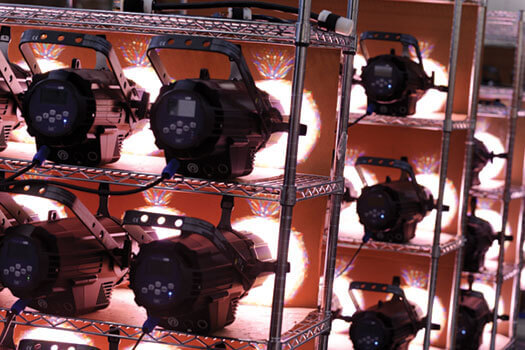
LED spotlights are tested for their staying power at company headquarters for Electronic Theatre Controls in Middleton, Wisconsin, ensuring that they’ll soon be ready for installation in a client’s performance space.
Fred Foster knew that he could build better lighting for the theater — so he built a global company from the ground up.
No actors are on stage, but the show has already begun for Fred Foster x’79, chief executive officer of Electronic Theatre Controls (ETC) in Middleton, Wisconsin. From a cramped lighting booth at American Players Theatre (APT), he watches the audience begin to trickle in for tonight’s performance of Shakespeare’s The Two Gentlemen of Verona.
As he awaits showtime at the outdoor playhouse in the Spring Green hills, Foster is schmoozing with Eliot Garfield, APT’s head electrician. The palaver seamlessly blends chitchat and casual market research: “How is this working out?” “Did you hear that so-and-so is working for us now?”
It’s a commonplace that leaders of successful corporations love the figurative spotlight. But here’s Foster, whose company has become the go-to source of actual spotlights and controls for the theater and live-performance industry since he left the UW–Madison theater department in the 1970s — and he’s happiest behind the scenes.
Focusing on the nuts and bolts of live performance has fertilized a remarkable success story. Since 1975, when Fred Foster, his brother Bill ’76, and two fellow undergraduates made their first computerized lighting console, ETC has grown into a privately held behemoth of the theatrical-lighting industry, with offices and service centers in Orlando, Hollywood, London, Rome, Germany, the Netherlands, and Hong Kong. And it continues growing. ETC is doubling the size of its New York office and outfitting an eight-acre building in Mazomanie, Wisconsin, to ramp up the manufacture of stage rigging, its newest product line.
Foster knows that in a performance, lighting creates the mood and focuses attention. But in the booth tonight, the spotlight is on technology, and that suits him just fine. Indeed, for many years, Foster tended to shun live theater. “I wanted to be backstage — [I] could not relax and concentrate on the show. I would be looking at what kind of lighting it was, or thinking about the action backstage,” he says.
Later, as he settles into a seat in the audience at American Players, Foster knows that many of the spotlights above the stage have been donated by his company — and they are just some of the more than 3 million Source Four light fixtures that ETC has made.
As with almost all of ETC’s output, the spotlights are produced in Middleton, where about six hundred people design, test, manufacture, and sell lights, dimmers, and controls to markets worldwide. A company that spent years building components in a garage has a comprehensive brag sheet that includes a system installed during the complete refurbishment of Moscow’s historic Bolshoi Theatre.
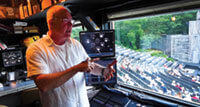
As the seats begin to fill at American Players Theatre, Fred Foster is where he loves to be: behind the scenes in the control booth, knowing that his company’s lighting will play a lead role in focusing the audience’s attention and creating a mood on the stage. Photo: David J. Tenenbaum.
THEATER has been Foster’s passion since his student days at Madison’s Memorial High School. During his two years at UW–Madison, his fascination with stagecraft was further inspired by Gilbert Hemsley, a nationally renowned lighting designer who taught during the 1970s. “He was a dynamic, exciting professor who drew moths to the flame of his intensity,” Foster remembers.
Trips with Hemsley, including one in 1975 to design lighting for two Metropolitan Opera productions, cemented a lifelong interest in the work of the behind-the-scenes people who make theater happen.
In the 1970s, computer technology was coming of age, and Mitchell Theatre in the newly built Vilas Hall sported expensive electronic lighting controls. But Fred and Bill, a UW physics student, were appalled by the clunky apparatus. The brothers claimed — with equal parts youthful chutzpah and technical insight — that they could make a better control console for $5,000.
With help from fellow students Gary Bewick ’77 and James Bradley ’77, the brothers produced a new control console a year later. A key step in proving the invention’s legitimacy almost backfired, however. In early 1977, the foursome wangled their way into the Wisconsin Union Theater for a big gig: controlling lights for an opera that was to be simulcast in color on public television and in stereo on public radio. But at the dress rehearsal, when Bewick and Bill Foster plugged in their revolutionary console, the entire theater instantly went black.
“We were thinking, ‘What a coincidence! It couldn’t possibly be us; we are drawing almost no electricity. How could we blow the circuit breakers?’ ” Bewick recalls.
But he and Bill quickly discovered that they were indeed the culprits. After a hasty workaround, the show went on.
As passionate members of the Hoofer Sailing Club who made it clear that they would rather be sailing, the four became known in the theater world as “the flakes from Wisconsin.” Bewick says that he and Bill, but not Fred, “wanted to sell the concept to someone and get rich quick. We did not want to do it ourselves.”
Although nobody wanted to buy the design outright, ETC sold about one hundred and fifty consoles to another company, which sold them under its own label.
In 1982, a major contract with Disney World gave ETC, by then selling under its own name, a much-needed shot of credibility. By 1990, Bewick says, Fred Foster had “mortgaged the company” to buy a much larger maker of dimmers for stage lights and moved about twenty-five employees from New York state to Middleton. Since then, ETC has expanded into event and architectural lighting, and the company has grown into a global powerhouse with hundreds of products and customer service that’s available 24/7.
At ETC’s company headquarters in Middleton, a workforce of some 600 people designs, tests, manufactures, and sells lights, dimmers, and controls to theater and performance spaces around the world.
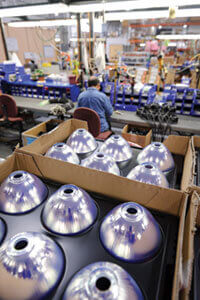
At ETC’s company headquarters in Middleton, a workforce of some 600 people designs, tests, manufactures, and sells lights, dimmers, and controls to theater and performance spaces around the world.
WITH his background in the sometimes-nerve-racking business of live theater, Foster honors the adage “the show must go on,” saying, “When you have two thousand people in the seats, the lighting has to perform.”
Garfield of APT says Foster’s company always comes through. “[ETC] operates the best help desk I have ever dealt with,” he says. “After-hours help is not just somebody eating pizza in front of the TV. They know showtime is showtime.”
One summer, Garfield notes, mice destroyed a critical dimmer component. An ETC employee met someone from APT in Cross Plains to hand off a replacement part — a delivery that allowed the actors to take their places on the Spring Green stage just in time. (At APT, those components are now housed in a mouse-proof fortress.)
Presumably, mice will not be a problem in the new Fredric March Play Circle in Memorial Union, which will be outfitted with a donated ETC system, on the proviso that the company can use the house as a test bed for its newest innovations.
ETC’s Middleton headquarters will house the people and equipment needed to build LED spotlights, fulfilling Fred Foster’s commitment to keep his workforce stateside.
ETC’s exhaustive UW–Madison pedigree started long before the company was born. Fred’s father, G.W. (Bill) Foster, was a law professor, and his mother, Jeanette, was an academic staff member. Fred has fond memories of his childhood. “[The] UW was such a nice environment to grow up in,” he says. “It would drive my mother crazy, but Dad would call up at five [o’clock] and say, ‘Can we have so-and-so for dinner?’ It might be a professor or a colleague from my father’s civil rights days. We kids and our friends were encouraged to participate. One afternoon, Pat Lucey ’46 — when he was governor — [came by boat] across the lake for a beer.”
ETC hires graduates from UW–Madison’s engineering and theater departments whenever possible, along with other veterans of the theater. “If you’ve been in theater,” Foster says, “you can deal with labor, you can deal with transporting too much stuff in too little space in too little time.”
In 1983, Foster married Susan Titus ’74, and she served as ETC’s production manager until 1990, when she left the company to devote more time to their two children. After years in the computer industry, Bewick recently returned to ETC to work on technology development. Bill Foster represents the 11th Congressional District in Illinois. And the fourth co-founder, Bradley, is a managing director of a business consulting firm in New York City.
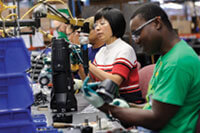
ETC’s Middleton headquarters will house the people and equipment needed to build LED spotlights, fulfilling Fred Foster’s commitment to keep his workforce stateside.
TODAY, ETC, a company birthed on technological innovation, is finding its way during an industry transition to energy-efficient, light-emitting diode (LED) spotlights. Foster prefers the full-spectrum photons emitted by the glowing metal filament in an incandescent bulb to the tight wavelengths of LEDs, which create unpleasant flesh tones. He had to be “dragged kicking and screaming” into making the change, he says.
But now, having acquired a technology that blends multiple colors of LED in a single spotlight, the company is refining software to combine light quality and speed of setup with energy efficiency.
The company’s new LED spotlights will be locally grown. The metal stamping, bending, assembly, and painting of the lights — like their predecessors — will be done at ETC’s Middleton headquarters, which was completed in 2004, and significantly increased in square footage in 2008. “We could get them produced, in good quality, from China, just for what we pay for the parts, but … to potentially put a few pennies in our pocket at the expense of our workforce is not the kind of business we want to be in,” Foster says.
His rules for business start and end with people. “I think the biggest part of our success is people who are incredibly good at what they do,” he says. “If you concentrate on getting and keeping the best people, all the things that business sages say you should do will happen.”
Others account for ETC’s success by pointing to Foster himself. “It’s Fred’s passion,” says Bewick. “Theater was Fred’s first love — the business acumen was an afterthought. ETC was never about making money at all costs. Fred and ETC are essentially indistinguishable.”
Mark Stanley MFA’86, who worked at ETC with a crew of fewer than one dozen in the early 1980s, agrees. “He did not come at it from the business or manufacturer’s point of view; he is first and foremost a theater practitioner. … As ETC grew, Fred never lost touch with the theater world,” he says.
Stanley, today an associate professor of lighting design at Boston University, says ETC’s “seamless operation” paid off last spring while lighting an opera at the refurbished Mariinsky Theatre in St. Petersburg, Russia. “I was able to program the whole show on a laptop and put it on a memory stick and plug it in. It’s not that the design did not need revision — all designs do — but this gave us the format and saved a huge amount of time on location,” he says.
With a nod to his company’s modest — but plucky — roots, Fred Foster enters his Middleton office through a garage door.
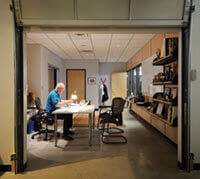
With a nod to his company’s modest — but plucky — roots, Fred Foster enters his Middleton office through a garage door.
FRED FOSTER is so proud of his roots in a garage that he enters his windowless office at ETC’s fancy headquarters through a garage door. But over time, this guy who would rather be sailing has evolved into an industry leader.
In 1990, after space was added at a previous Middleton location to consolidate the company following an acquisition, Foster recalls seeing all of his employees’ cars in one place for the first time. “By the time I got to the office, I felt sick to my stomach,” he says. “Up until this point, if ETC had blown up, I’d have gone back to school or gotten a real job. Now I realized that ETC was responsible for all of those car payments. Instantaneously, it changed my attitude — from taking any risk and not caring, to realizing that more is at stake. Now we have families with children and grandchildren.”
Another breakthrough occurred years later, when, leery of growth for its own sake, Foster discussed his company with legendary Madison builder Marshall Erdman ’48. “We were growing really quickly, putting every penny back in, living hand-to-mouth,” he says, and some in the company wanted to slow down. “I told Marshall, ‘It’s really about the people.’ He stopped me and said, ‘Then you can’t stop growing, because if you stop, they will become complacent, or get bored, and go off on their own and take everything you have taught them.’ ”
As Foster recounts the story on the late-night drive home from Spring Green, he says the conversation left him with two violently contradictory images: “One was a mushroom cloud that would keep expanding, creating challenges, drawing people up into the vortex. The other image was a treadmill that you can never get off of.”
Both images apply to a company that is going further into other markets, including stage rigging and architectural lighting, and developing that factory in Mazomanie. Foster can’t avoid contrasting the reality of a company with offices on three continents with the vision of the young sailboat racers who founded it.
“We did not start the company with the idea that it would last for thirty-eight years,” he says. “It was really a lark.”
David J. Tenenbaum MA’86 writes for The Why Files (whyfiles.org) and covers research for University Communications.
Published in the Winter 2013 issue


Comments
Tony Hartmann May 21, 2014
Fred’s an innovator and entrepreneur in the truest sense. We went to high school together and even back then he was a magnet, drawing others toward him. Way to go Fred!